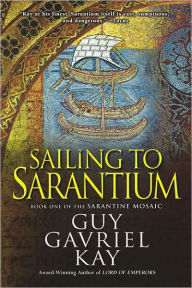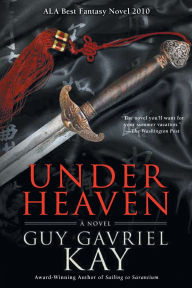Children of Earth and Sky Is an Epic Story About Why Stories Matter
 Is there anything better than a new book by a favorite author—that pleasant feeling of near certainty that it is going to give you exactly what you need? As I settled in with Guy Gavriel Kay’s Children of Earth and Sky, I was hoping it would trigger the same feelings as his earlier books, embody the qualities that have made him one of my most beloved authors. And oh man, does it: this is an immensely satisfying novel, both familiar and different, and the author’s strongest work in a decade.
Is there anything better than a new book by a favorite author—that pleasant feeling of near certainty that it is going to give you exactly what you need? As I settled in with Guy Gavriel Kay’s Children of Earth and Sky, I was hoping it would trigger the same feelings as his earlier books, embody the qualities that have made him one of my most beloved authors. And oh man, does it: this is an immensely satisfying novel, both familiar and different, and the author’s strongest work in a decade.
Children of Earth and Sky
Children of Earth and Sky
Hardcover $27.00
It centers on a pseudo-Renaissance world of the south and eastern edge of Europe, encompassing a time akin to the glittering heyday of the Italian city-states, the Ottoman Empire, and Austria-Hungary, spanning the plains of Mittleuropa from the shores of the Mediterranean sea to the heart of conquered Constantinople. Two wealthy trading cities, Dubrava and Seressa, jockey for power and wealth across a narrow sea, sending spies, merchants, and diplomats back and forth for information and advantage.
The cities must step warily, as the lie in the shadow of two major military powers: Obravic, and the Osmanli Empire, centered on its new capital of Asharias (formerly known as Sarantium, a detail that will interest longtime Kay readers) and conquered from the Jaddite faith 25 years earlier. The border wars between these states are reaching a breaking point for the Jaddites, as the Osmanli soldiers prepare to besiege Obravic’s exhausted outlying forts, and not for the first time. The balance of power is poised to tip one way or the other, whether due to conflicts of faith, family, or politics.
It centers on a pseudo-Renaissance world of the south and eastern edge of Europe, encompassing a time akin to the glittering heyday of the Italian city-states, the Ottoman Empire, and Austria-Hungary, spanning the plains of Mittleuropa from the shores of the Mediterranean sea to the heart of conquered Constantinople. Two wealthy trading cities, Dubrava and Seressa, jockey for power and wealth across a narrow sea, sending spies, merchants, and diplomats back and forth for information and advantage.
The cities must step warily, as the lie in the shadow of two major military powers: Obravic, and the Osmanli Empire, centered on its new capital of Asharias (formerly known as Sarantium, a detail that will interest longtime Kay readers) and conquered from the Jaddite faith 25 years earlier. The border wars between these states are reaching a breaking point for the Jaddites, as the Osmanli soldiers prepare to besiege Obravic’s exhausted outlying forts, and not for the first time. The balance of power is poised to tip one way or the other, whether due to conflicts of faith, family, or politics.
Sailing to Sarantium
Sailing to Sarantium
In Stock Online
Paperback $16.00
We follow a small group of people from the disparate faiths and nationalities of these diverse lands, drawn together by the shifting politics of a particular moment in time. Each is living through great changes in their lives, torn by divided loyalties. There is Danica, a female bandit from a city of “holy” raiders, whose tragic family history has given her an unquenchable desire for revenge. There is Pero, a young painter from the west who is handed the commission of a lifetime in Asharias, along with a dangerous mission that may cost him his life. There is Leonora, the beautiful doctor’s wife, who is more than she seems, and Marin, the restless merchant’s son caught unawares in events much larger than himself. Their lives become entangled with those of the great and powerful by happenstance or by design—and each is forever changed.
In the best Kay fashion, there is an inevitability to the way these threads are woven together into an intricate tapestry, as if the full picture already exists, and we are being shown but glimpses. Some endings offer heartbreak, while others are not endings at all. Readers are seldom in safer or more understanding hands than they are while experiencing one of Kay’s epics: we can rest assured it is a tale completely told.
Readers who have been enjoying Kay’s experiments with the forms of myth, history, and narrative (seen most clearly in Under Heaven and River of Stars), will appreciate this book as an evolution of that work. He continues to play with the way the story is told, narrating in a kind, knowing omniscient voice that frequently pulls back to comment on the proceedings and make us aware of how these dramas (great and very small) may amount to something—or to nothing at all. He is telling us that all stories matter, whether they affect millions or only a few, whether they end prematurely, or go on to become rumor or legend.
We follow a small group of people from the disparate faiths and nationalities of these diverse lands, drawn together by the shifting politics of a particular moment in time. Each is living through great changes in their lives, torn by divided loyalties. There is Danica, a female bandit from a city of “holy” raiders, whose tragic family history has given her an unquenchable desire for revenge. There is Pero, a young painter from the west who is handed the commission of a lifetime in Asharias, along with a dangerous mission that may cost him his life. There is Leonora, the beautiful doctor’s wife, who is more than she seems, and Marin, the restless merchant’s son caught unawares in events much larger than himself. Their lives become entangled with those of the great and powerful by happenstance or by design—and each is forever changed.
In the best Kay fashion, there is an inevitability to the way these threads are woven together into an intricate tapestry, as if the full picture already exists, and we are being shown but glimpses. Some endings offer heartbreak, while others are not endings at all. Readers are seldom in safer or more understanding hands than they are while experiencing one of Kay’s epics: we can rest assured it is a tale completely told.
Readers who have been enjoying Kay’s experiments with the forms of myth, history, and narrative (seen most clearly in Under Heaven and River of Stars), will appreciate this book as an evolution of that work. He continues to play with the way the story is told, narrating in a kind, knowing omniscient voice that frequently pulls back to comment on the proceedings and make us aware of how these dramas (great and very small) may amount to something—or to nothing at all. He is telling us that all stories matter, whether they affect millions or only a few, whether they end prematurely, or go on to become rumor or legend.
Under Heaven
Under Heaven
In Stock Online
Paperback $16.00
Kay’s most consistent strength is an ability to create three-dimensional, sympathetic characters, and it is on strong display. He excels at creating an intimate space between the character and the reader; in his stories, that human connection is ultimately the point. His characters never feel like ciphers serving a thematic purpose, but rather people with complicated lives, facing messy circumstances. Few of us are, in the end, living in a legend of perfect proportions—we’re trying to get through the day and still be able to look at ourselves in the mirror in the evening. Even when dealing with vast swathes of people and forces of considerable power, Kay reminds us that stories are made up of particular people living particular lives, being faced with choices in a particular moment that might have been different on any other day—that’s what matters, and that’s what’s fascinating.
What author can you depend on to deliver every single time?
Kay’s most consistent strength is an ability to create three-dimensional, sympathetic characters, and it is on strong display. He excels at creating an intimate space between the character and the reader; in his stories, that human connection is ultimately the point. His characters never feel like ciphers serving a thematic purpose, but rather people with complicated lives, facing messy circumstances. Few of us are, in the end, living in a legend of perfect proportions—we’re trying to get through the day and still be able to look at ourselves in the mirror in the evening. Even when dealing with vast swathes of people and forces of considerable power, Kay reminds us that stories are made up of particular people living particular lives, being faced with choices in a particular moment that might have been different on any other day—that’s what matters, and that’s what’s fascinating.
What author can you depend on to deliver every single time?


